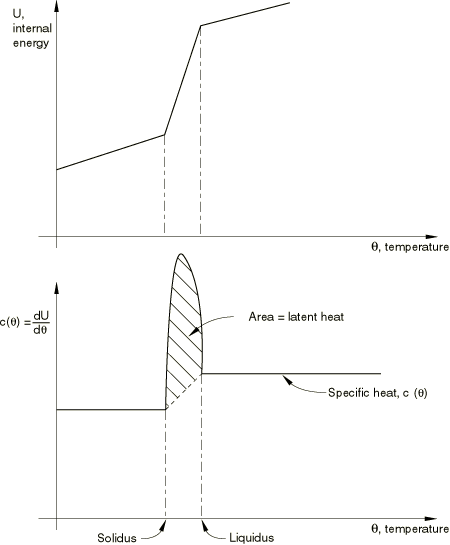Abaqus/Standard
uses the backward difference algorithm:
This operator is chosen for a number of reasons. First of all, we choose
from one-step operators of the form
because of their simplicity in implementation (for example, no special
starting procedures are needed) and well-understood behavior. For
such operators are only conditionally stable for linear heat transfer problems.
We prefer to work with unconditionally stable methods, because
Abaqus
is most commonly applied to problems where the solution is sought over very
long time periods (compared to the stability limit for the explicit form of the
operator, ),
and so choose .
Of these operators the central difference method, ,
has the highest accuracy. However, that form of the operator tends to produce
oscillations in the early time solution that are not present in the backward
difference form. Thus, we use :
backward difference. Introducing the operator,
Equation 5,
into the energy balance
Equation 4
gives
This nonlinear system is solved by a modified Newton method. The method is
modified Newton because the tangent matrix (the Jacobian matrix)—that is, the
rate of change of the left-hand side of
Equation 6
with respect to —is
not formed exactly. The formation of the terms in this tangent matrix is now
described.
The internal energy term gives a Jacobian contribution:
is the specific heat, ,
outside the latent heat range, and is
if
at the integration point, where
and
are the liquidus and solidus temperatures and L is the
latent heat associated with this phase change.
In severe latent heat cases this term can result in numerical instabilities,
as the stiffness term
is small outside the solidus-liquidus temperature range and is very stiff
inside that rather narrow range. To avoid such instabilities in those cases
this term is modified to a secant term during the early iterations of the
solution to a time step. Since the modification occurs only in cases involving
latent heat, it affects only those problems.
The conductivity term gives a Jacobian contribution:
The second of these terms is typically small, since the conductivity usually
varies only slowly with temperature. Because of this, and because the term is
not symmetric, it is usually more efficient to omit it. This term is omitted
unless the unsymmetric solver is chosen. Prescribed surface fluxes and body
fluxes can also be temperature dependent and will then give rise to Jacobian
contributions.
With film and radiation conditions, the surface flux term gives a Jacobian
contribution:
For film conditions,
while for radiation,
These terms are included in exactly this form in the Jacobian. The modified
Newton method is then
For purely linear systems
Equation 7
is linear in
and, hence, in ,
so a single equation solution provides the .
Since the method usually is only a minor modification of Newton's method,
convergence is rapid.
Abaqus/Standard
uses an automatic (self-adaptive) time stepping algorithm to choose
.
This is based on a user-supplied tolerance on the maximum temperature change
allowed in a time increment, and the increment is adjusted according to this
parameter, as well as the convergence rate of
Equation 7
in nonlinear cases.
The first-order heat transfer elements (such as 2-node link, 4-node
quadrilateral, and 8-node brick) use a numerical integration rule with the
integration stations located at the corners of the element for the heat
capacitance terms. This means that the Jacobian term associated with the
internal energy rate is diagonal. This approach is especially effective when
strong latent heat effects are present. The second-order elements use
conventional Gaussian integration. Thus, second-order elements are to be
preferred for problems when the solution will be smooth (without latent heat
effects), whereas the first-order elements should be used in nonsmooth cases
(with latent heat).
The HEATCAP element is available for modeling lumped heat capacitance at a
point. The associated concentrated film and concentrated radiation loading
options are specified by the user. These loading options are also allowed in
coupled temperature-displacement, coupled thermal-electrical, and coupled
thermal-electrical-structural analyses.
